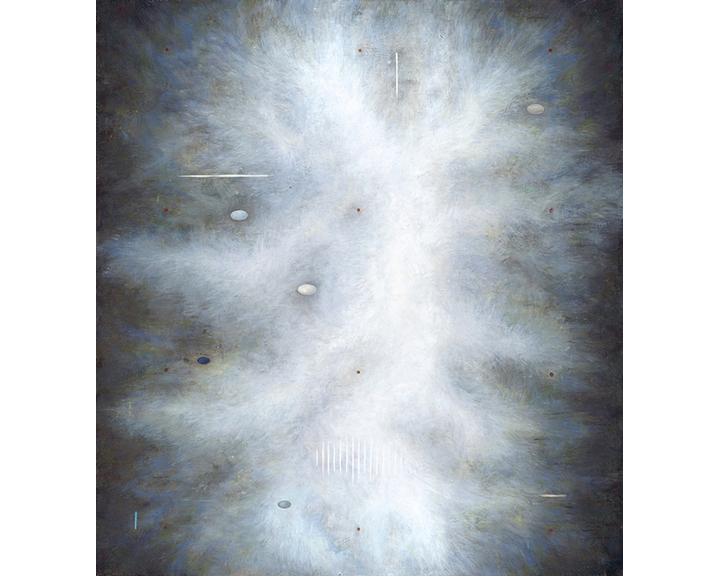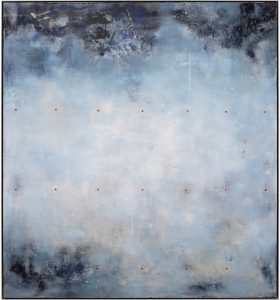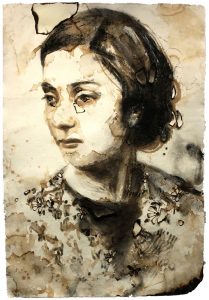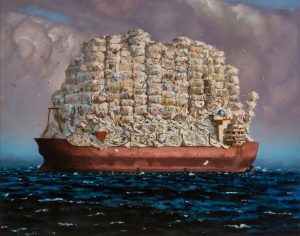
Raphaelle Goethals – Currents I
Creativity is the power to reject the past, to change the status quo, and to seek new potential…creativity is the power to act.
-Ai Weiwei
Some of the greatest accomplishments of humanity have emerged from bleak times. The European Renaissance grew out of the Medieval world. The Enlightenment grew from nascent democratic ideas opposing autocratic rule. Great advances in civilization often occur in response to the difficulties we are forced to overcome, like the health, social, emotional, and economic hardships we face globally right now. What do these triumphant achievements in humanity have in common? Art. Art thrives in times of adversity because artists understand transformation. That’s what they do every day. They let go of rules and expectations, to create something unique to their own vision, by connecting with their intuition and inner voice. Artists can create beauty out of nature—literally—because they can transform natural elements like Abiquiu’s pink hills and blue lapis lazuli into ground pigments to use as their artistic medium. Artists recognize the life-preserving value of water-holding vessels they can create from the clay earth upon which we all walk, and artists transform the banal into the beautiful, elevating these materials in human consciousness.
History to me is not a noun. It’s a verb. History is constantly changing…You can rewrite history…believe that art can change people’s…minds, by changing their perceptions and bringing awareness. I think then political and social change comes after.
-Hung Liu
Artists are working today to transform human consciousness, just as they have throughout history. If we look carefully, they show us a better way forward by focusing on spirituality, compassion, environment, and equality.
Click on the linked words and images below, to explore additional revelatory artworks.
SPIRITUALITY
Raphaelle Goethals is a Belgian artist who moved to the United States decades ago to study abstract painting. She grew up looking at works by Northern European painters, standing in reverence in front of their works for hours on end. While she did not incorporate the figurative subject matter of those masterworks into her paintings, she took their pristine spiritual nature into her soul. The paintings Raphaelle Goethals makes today possess a pure, clear sense of light that seems to emanate from within. Raphaelle seems to push through the troubling societal issues by asking herself: How does an artist paint space? How to paint the idea of forever? Her paintings present as a physical response to how we are often “bombarded with information and increasingly used to a simultaneity of experiences.” By painting infinite space, Goethals clears not only her mind of the bombastic cacophony that assaults us, but she offers the viewer a space to experience that same clarity. She helps people viewing her paintings step out of an anxiety-ridden mental state and into a universal spiritual space that we seem to have forgotten exists. For this experience Raphaelle shares through her paintings, she elevates human consciousness in a way that nudges us toward a better future.
Raphaelle indicates her lack of identification with a single space by alluding to a dynamic concept of belonging in the universal spiritual sense, rather than the static qualities of a distinct scene. She provides in her paintings just the hint of a grid, or colored points on which to hang space and give the eye a place to rest as it wanders through the painting’s atmosphere. Viewing Raphelle Goethals’ paintings, like looking up at the stars, is ultimately an experience of partaking in the spiritual essence all living beings share.
EQUALITY
Jami Porter Lara’s artworks marry concepts and materials that are inherently inequivalent in both status and appearance. Her practice of merging these materials insists upon an ultimate equality that transcends socio-economic differences of civilization.
At first glance, Jami Porter Lara’s glistening, black works evoke visual connections reaching back to the origins of Native American black on black pottery, and forward to futuristic techno-works. This dichotomy in visual, material, and philosophical associations is part of the profound message inherent in Porter Lara’s art. She takes the ancient material of clay, which she excavates from the land in New Mexico, forms the clay to match her vision, then she harnesses the element of fire–like an alchemist–to transform that clay into an elegant vessel by firing it in a pit she dug outside her studio. Porter Lara’s transformative process, taking a basic natural material to its ultimate expression of visual sophistication, unifying that which was previously unequal. The clay she uses to shape her vessels is the result of centuries of decay. Historically, a particle of dust may have helped compose a vase or chalice for a king or queen. But like everything in the cycle of life, things that were once beautiful and exalted become exactly equal to all other things when they return to their ultimate source–particles of earth. All things in nature–whether bodies that once lived, or natural objects–break down into the same fundamental elements.
Another aspect of equality Porter Lara’s work rebalances is that of socio-economics. By labeling her artworks with letters and numbers, she implies archaeological nomenclature. A naming device such as this implies that an object is important enough to be studied by future civilizations, for its beauty, function, or societal implication. In this case, Porter Lara has used the plastic liter bottle as the inspiration for the sculptural shape. The vessel’s articulated bottom and spouts immediately bring to mind the common place plastic bottle that litters streets, garbage cans, landfills and convenience stores world-wide. For wealthy societies, this plastic bottle might represent menacing litter. But for others, this insinuation of the plastic liter bottle symbolizes life itself. For people traveling across the desert border from Mexico into the United States, working far from home in fields under the hot sun, or making the migrant trek from their homeland, a single plastic bottle is the key to their continued existence. By merging the elevated with the dispossessed, both in concept and material, Jami Porter Lara’s artworks shine a light on the innate equality of all human beings: past, present, and future.
COMPASSION
Artist Monica Lundy has spent her life living in different cultures, often cultures where the rights of marginalized members of society are squelched. She grew up in Saudi Arabia, and has lived between Italy and the United States as a mature artist. Lundy paints, burns, draws, and sculpts images of people she never knew, but took into her heart, from photographs and stories she gathered on her journey.
Lundy practices compassion for women who have been mischaracterized throughout history. Many of the women Lundy paints were inhabitants of mental institutions and jails in the early 1900s. She paints from photographs retrieved from psychiatric and incarceration files, always devoting only one portrait as a memorial to each woman. The root of Lundy’s compassion for her subjects comes from the injustices they suffered, such as being locked up for such “crimes” as promiscuity, disobeying their husbands, or being too loud. She does not judge or preach about the past treatment of these women in her paintings; she simply embraces the facts of life of women she never knew, embodying compassion by virtue of her attention. Monica “paints” with coffee and charcoal, incorporating these elements of everyday reality of the women into her creations, as if the shared materials help her better comprehend their reality. She uses fire as a transformative element of creation and destruction in the portraits she creates, almost as if this primal element has been used to both destroy and empower these (and all) women at different points in their lives. By using materials and presenting imagery of women who suffered unjustly in the past for “offenses” we regard as fully acceptable today, Monica Lundy helps us experience the feeling of interconnectedness that unites humankind.
As Buddhist teacher and psychologist Jack Kornfield points out, art is a channel that can elevate our happiness and the progress of our civilization:
We can see the fiction and the manipulation that often accompanies politics and the media’s attempt to scare us and capture our attention through our fears. We can also look around and see that there is enormous beauty in the world and zillions of acts of kindness at the very same time. Depending on what seeds we water and where we direct our attention, we can live in fear and confusion or we can activate many other powerful dimensions of our own heart and mind—of caring, confidence, equanimity, and well-being. These are innate in us and with care can be enhanced and awakened.
You ask, can changing your inner life make a difference in the troubles of the world? Nothing else can! No amount of technology, computers, Internet, artificial intelligence, biotech, nanotechnology, or space technology is going to stop continuing racism, warfare, environmental destruction, and tribalism. These all have their source in the human heart.
The outer developments that are so remarkable in our human world now need to be matched by the inner developments of humanity. These inner developments can awaken compassion for ourselves and others. They grow from loving attention and awareness, they develop a deep sense of interconnection, of care and social and emotional wisdom. This is the great task of modern times. To bring the inner level of human consciousness up to the level of our outer development. Nothing else will really make a difference.
-Jack Kornfield
ENVIRONMENT
Scott Greene’s oil on canvas over panel work, MOBRO: High Seas Drifter, references the Mobro 4000, a barge tasked with carrying over six million pounds of trash from New York to North Carolina. The barge was forced to return to New York after five months adrift, being rejected by three foreign countries and several states. Greene reexamines the tale by rendering the ship in his own artistic style, transforming it from a frumpy industrial transportation vessel into a romanticized beacon of beauty set against a stunning sunset. Birds swarm melodiously above the barge, with the white bails sagging under their own weight, like the curls of a colonial powdered wig. There is no crew or physical presence aboard the ship, suggesting that the very material that represents a product of human consumption has now consumed its producers.
Scott Greene’s work portrays an exquisite level of artistic skill and knowledge of art history, the combination of which immediately captures the viewers’ attention and allows them to visually realize the effects of human excess. He uses the immense beauty he is able to create from current environmental topics to reframe our perspective and return to more diligent stewardship of nature. The actual MOBRO barge spurred greater societal concern about lack of landfill space, prompting a tidal wave of recycling initiatives. Greene seeks for his painting to have the same massive impact as its tragic inspiration.
Scott Greene’s paintings are widely recognized for revealing the importance of our stewardship of the environment. MOBRO: High Seas Drifter is currently featured in an important traveling museum exhibition titled “Environmental Impact”, along with several other of Greene’s paintings.
ADDITIONAL INSPIRATION
Hung Liu lived through a dark time in history—the Cultural Revolution. She recalls “Intellectuals were prosecuted, books were burned. Millions of us were sent to the countryside or labor farms. It was a modern dark age. Nonetheless, a book was circulating among us…”Jean-Christophe: The Epic Novel,” by Romain Rolland. We felt the unspoken closeness with the hero-his disillusioned childhood, his escape from home, his relationships with his friends, lovers and pupils. His struggle in life became a moral guide and a spiritual anchor for my generation. Still, it remains a mystery to me how a French writer’s 1904-1912 novel about an artist in the German-occupied Rhineland could have been so influential for so many of my Chinese contemporaries during China’s darkest time in the mid-1960s. My favorite (is) the final chapter, “The New Dawn” After carrying a child across the river, Jean-Christophe asks the child who he is. The Child answers “I am the day soon to be born.”
History to me is not a noun. It’s a verb. History is constantly changing…You can rewrite history…I believe that art can change people’s…minds, by changing their perceptions and bringing awareness. I think then political and social change comes after.
-Hung Liu
Most of us know the feeling of being moved by a work of art, whether it is a song, a play, a poem, a novel, a painting, or a spatio-temporal experiment. When we are touched, we are moved; we are transported to a new place that is, nevertheless, strongly rooted in a physical experience, in our bodies. We become aware of a feeling that may not be unfamiliar to us but which we did not actively focus on before. This transformative experience is what art is constantly seeking.
I believe that one of the major responsibilities of artists – and the idea that artists have responsibilities may come as a surprise to some – is to help people not only get to know and understand something with their minds but also to feel it emotionally and physically. By doing this, art can mitigate the numbing effect created by the glut of information we are faced with today, and motivate people to turn thinking into doing.
Engaging with art is not simply a solitary event. The arts and culture represent one of the few areas in our society where people can come together to share an experience even if they see the world in radically different ways. The important thing is not that we agree about the experience that we share, but that we consider it worthwhile sharing an experience at all. In art and other forms of cultural expression, disagreement is accepted and embraced as an essential ingredient. In this sense, the community created by arts and culture is potentially a great source of inspiration for politicians and activists who work to transcend the polarising populism and stigmatisation of other people, positions, and worldviews that is sadly so endemic in public discourse today.
Art also encourages us to cherish intuition, uncertainty, and creativity and to search constantly for new ideas; artists aim to break rules and find unorthodox ways of approaching contemporary issues.
-Olafur Eliasson
CURRENT EXHIBITION AND NEWS

BURNED: WOMEN AND FIRE
featuring Judy Chicago, Etsuko Ichikawa, Hung Liu, Monica Lundy, Lien Truong, Karen Yank, Meridel Rubenstein, Julie Richard Crane and Jami Porter-Lara
On View Through April 4, 2020
Burned: Women and Fire features artists who—like the alchemical Phoenix who burns and rises from the ashes anew—integrate their collective experience with fire and burning to create their art. [read on here]
2020 EXHIBITIONS
Make your travel plans to join us!
February 28 | Burned: Women and Fire featuring Judy Chicago, Lien Truong, Monica Lundy, Etsuko Ichikawa, Hung Liu, and more
May 15 | Hunt Slonem: Fluffle
June 19 | Drew Tal
July 17 | Raphaelle Goethals
August 14 | Hung Liu Retrospective Works
September 11 | Scott Greene + Walter Robinson
October 1-4 | Dallas Art Fair
October 16 | Igor Melnikov + Georges Mazilu
November 20 | Rusty Scruby
TURNER CARROLL ARTISTS IN MUSEUMS
JUDY CHICAGO Judy Chicago BALTIC Centre for Contemporary Art Gateshead, UK On View Through April 19, 2020 On Fire: Judy Chicago Fireworks with Photographs by Donald Woodman Through the Flower Artspace Belen, NM Ticketed Opening July 26, 2020 Judy Chicago: A Retrospective de Young Museum San Francisco, CA Opening summer 2020 The Dinner Party Brooklyn Museum Brooklyn, New York Permanent Installation
JIM DINE Enigma Pinocchio Villa Bardini at Leonardo da Vinci Art School Firenze, Italy On View Through March 22, 2020
SCOTT GREENE CURRENT TRAVELING EXHIBITION Environmental Impact II The North Carolina Arboretum Asheville, NC On View Through May 10, 2020 Dennos Museum Center Traverse City, MI Opens June 7, 2020 Alexandria Museum of Art Alexandria, LA Opens March 1, 2021
HUNG LIU Woman-Made: From the Collection Leepa-Rattner Museum of Art Tarpon Springs, FL On View Throught April 19, 2020 Myriad Treasures: Celebrating the Reinstallation
of the Soreng Gallery of Chinese Art Jordan Schnitzer Museum of Art Eugene, OR On View Through February 14, 2021 Hung Liu Retrospective Smithsonian National Portrait Gallery Washington, D.C. Opens May 2021
MERIDEL RUBENSTEIN
Trinity: Reflections on the Bomb
Albuquerque Museum
Albuquerque, NM
Opens May 23, 2020
Breath Taking
New Mexico Museum of Art
Santa Fe, NM
On View Through September 13, 2020




